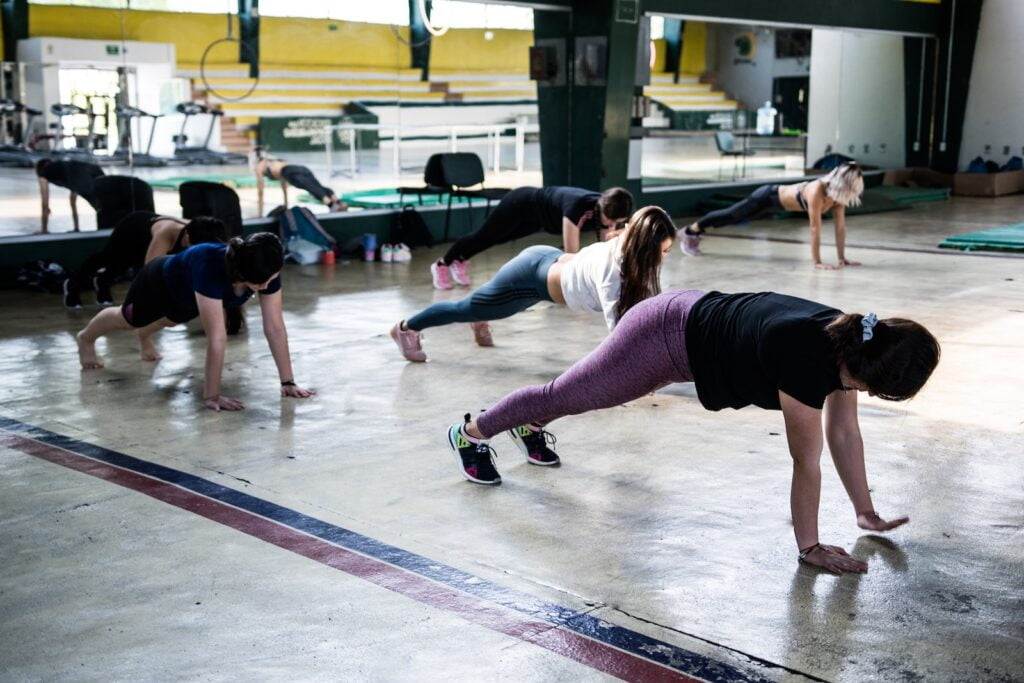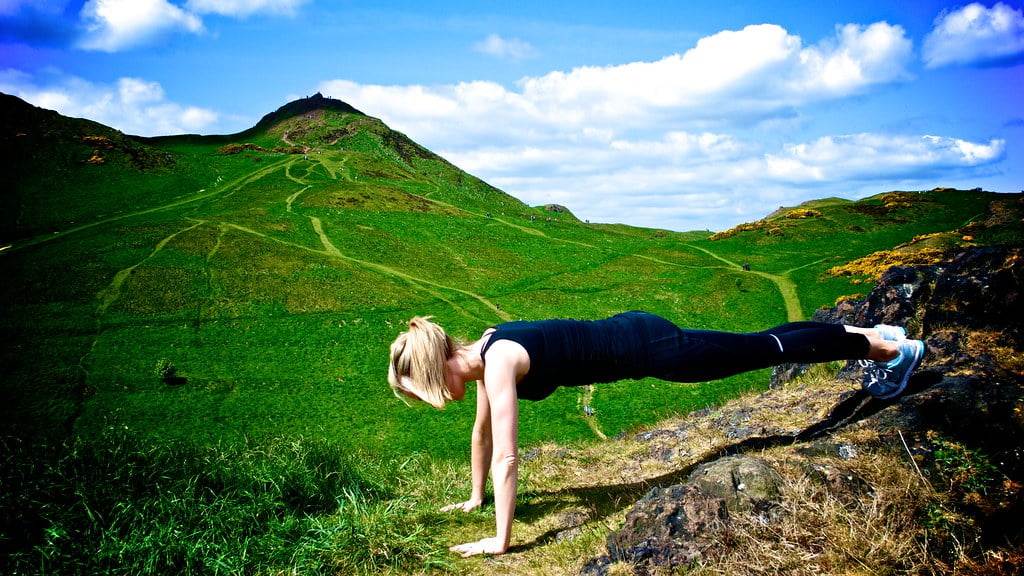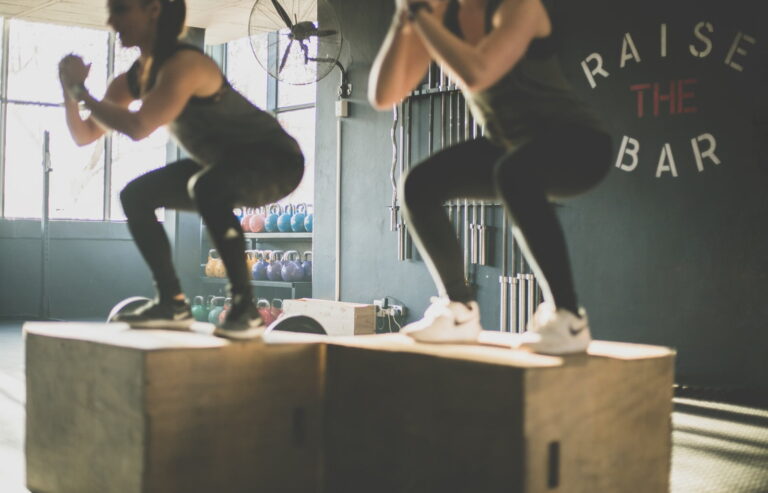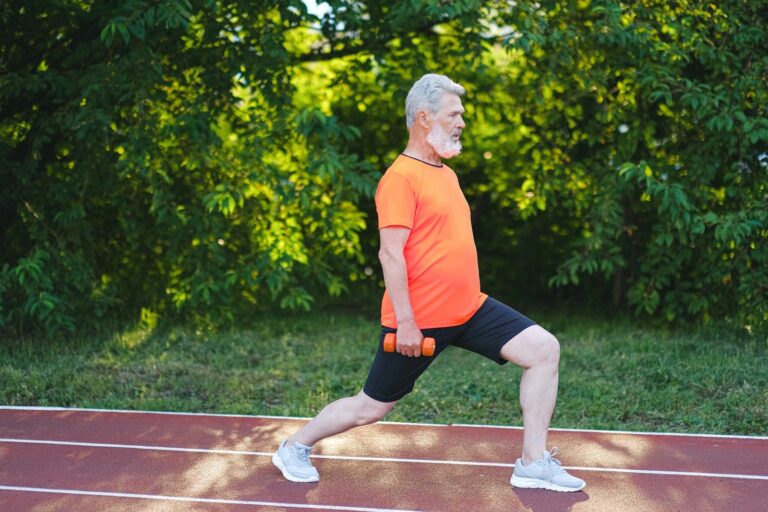The cornerstone of push-up mastery lies in comprehending the muscles it mobilizes. Engaging a diverse array of muscle clusters—encompassing the chest, shoulders, triceps, and core—guarantees the utmost advantage from this versatile exercise. Familiarizing yourself with these muscle locations also bolsters your ability to maintain impeccable form throughout each rep.
Finaly, a smattering of adjustments unlocks the door to effortless push-up perfection. Read on, and prepare to absorb invaluable knowledge! With lucid guidance and timely pointers, you’re destined to triumphantly conquer the elusive perfect push-up!
Table of Contents
Overview Of Pushup Exercise
Pushups are a popular upper body and trunk stability exercise. Also, they can be done practically anyplace without equipment! Push ups require whole body movement. Proper pushups work the chest, shoulders, triceps, abs, and back. Wide arm or incline push ups can increase intensity or target certain areas.
Benefits Of Pushups
Pushups reign as a formidable force in the realm of comprehensive muscle fortification and stamina enhancement. These dynamic exercises not only hone your pectorals, biceps, and dorsal regions but also awaken your core and lower extremities. The rewards of habitual pushup practice are vast and varied, as outlined below:
- Core Strength: Doing regular pushups strengthens the abdominal muscles that make up our core, providing us with greater balance and stability.
- Leg Muscles: Not only do they work upper body muscle groups like the shoulders, triceps and pectoralis major (chest) muscles, but pushups also activate lower extremities such as quads and glutes. This makes them an ideal way to build overall muscle mass in both areas at once.
- Explosive Power: Pushups allow athletes to move more weight quickly through their joints without straining. They help martial artists improve agility and punching speed.
Pushups have been shown to be beneficial, but proper form is essential for best results. To get these great benefits, the next section will cover proper pushup tips!

Personalized Push-up Recommendations: Reps, Sets, and Frequency
Striving for an effective push-up routine? It’s essential to consider reps, sets, and frequency to match your fitness level and goals. In addition, varying sentence lengths and complexities will be used to enhance readability.
Starting Point: Reps and Sets
To begin with, it’s generally advised to perform 3-4 sets of 5-10 pushups. As you grow stronger and gain endurance, you can incrementally raise the number of repetitions.
- Repetitions: Initially, aim for 5-10 pushups per set. As you progress, work towards 10-15 reps in each of your 3-4 sets.
- Sets: Kick off with 3-4 sets, then gradually increase as you become fitter. Strive for 3-4 sets of 10-15 reps, resting 30-60 seconds between each.
Frequency: Balancing Workouts and Recovery
Integrating pushups into a well-rounded fitness routine is key. You can execute them several times a week, but remember to allow for recovery.
- Rest Days: Allocate at least one day of rest between push-up sessions to facilitate muscle recovery and prevent overtraining. A common recommendation is to perform pushups 2-3 times per week.
- Rest Between Sets: Schedule 30-60 seconds of rest between sets to stave off fatigue and injury.
The Importance of Form and Breathing
Proper form and correct breathing are vital for reaping the benefits of pushups and minimizing injury risk.
- Form: Position your hands slightly wider than shoulder-width apart, keep elbows close to your body, engage your core and glutes, and maintain a straight body line from head to toe.
- Breathing: Inhale deeply through your nose while lowering yourself, and exhale as you press back up to the starting position.
Tips For Doing Pushups Properly
Doing a pushup correctly is an art form. It’s like walking on air, dancing with the stars and elevating your body to new heights!
| Benefits | How to Achieve Them | Expected Results |
|---|---|---|
| Increased Strength | Full Range of Motion | Building Muscle Mass & Endurance |
| Improved Posture | Engage Core Muscles | Strengthened Shoulders & Chest |
| Aerobic Exercise | Keep Your Body Straight | Enhanced Cardio Fitness Level |
Keep your body straight from head to toe to maximize exercise benefits. Squeeze your glutes during each repetition and engage all muscle groups by moving slowly and steadily. Result? A tougher chest, shoulders, arms, and back! Aerobic exercise improves posture and cardio fitness.
Muscle Groups Involved In A Push-Up
Mastering push-ups involves the coordinated effort of various muscle groups. This exercise targets not only the chest and arms but also the core, shoulders, and back. By understanding the roles of different muscles, you can optimize your pushup performance.
Essential Muscles for Push-ups
When executed correctly, pushups engage several key muscle groups, including:
- Pectoralis major: This chest muscle lifts and stabilizes your upper body throughout each rep.
- Triceps: Responsible for extending the elbow joint, triceps help you press your body off the floor.
- Shoulders: Your deltoids aid in maintaining proper form and contribute to the pushing movement.
- Back: The latissimus dorsi, or lats, enhance shoulder stability and power while keeping your elbows tucked in.
- Core: Engaging your core muscles helps maintain a straight body line and supports your torso during the exercise.
- Glutes: Activating your glutes keeps your hips stable, reducing lower back stress and allowing you to concentrate on a well-executed pushup.
Optimizing Your Push-up Form
To make the most of your pushups and engage the right muscles, adhere to the following guidelines:
- Hand Positioning: Place your hands slightly wider than shoulder-width apart.
- Elbow Alignment: As you lower yourself, keep your elbows close to your body.
- Core and Glute Activation: Maintain tightness in your glutes and core muscles.
By understanding the interplay of multiple muscle groups during pushups, you can refine your technique for a safer, more effective workout.
Mastering the Perfect Push-up: A Comprehensive Guide
Achieving the perfect push-up requires practice, focus, and understanding of technique. Follow this step-by-step guide to improve your push-up skills and overall fitness.
Step 1: Proper Positioning
To begin your push-up journey, start by establishing the correct form:
- Kneel: Place your hands shoulder-width apart under your shoulders.
- Straight back: Maintain a straight back throughout the movement.
- Extend arms: Gently move until your arms are fully extended and your feet are flat behind you.
Step 2: The Push-up Execution
Now that you’re in the correct position, it’s time to perform the push-up:
- Lower: Gently lower yourself toward the ground while inhaling deeply through your nose, stopping when your elbows reach a 90-degree angle or just below parallel.
- Exhale: Exhale as you press yourself back up to the starting position.
- Repeat: Continue with repetitions as desired.
Preparing for Push-ups
Ensure you’re ready for pushups by following these preparation tips:
- Space: Find a flat, stable surface with enough space.
- Clothing: Wear comfortable clothes for free movement.
- Warm-up: Stretch your arms, shoulders, chest, back, and neck for two minutes to improve circulation and prevent injury.
Complementary Exercises for Push-ups
Diversify your workouts to maximize results and improve your push-up abilities:
- Bench and overhead presses: These weight-bearing exercises improve strength and bulk.
- Planks and crunches: Enhance push-up form and performance by targeting the core.
Increasing Strength and Endurance
Incorporating additional exercises can boost your push-up performance:
- Bodyweight exercises: Planks, mountain climbers, burpees, squats, and lunges work various muscle groups and strengthen bones.
- Resistance: Add weights or resistance bands to increase difficulty and enhance results.
Achieving Proper Push-up Form
Form and posture are crucial for effective pushups:
- Hand placement: Position your hands slightly wider than shoulder-width apart.
- Feet alignment: Keep your feet hip-width apart.
- Body activation: Engage your arms, chest, shoulders, core, and glutes during each repetition.
Breathing Techniques for Push-ups
Proper breathing is essential for optimizing push-up performance:
- Inhale: Breathe deeply before pressing down into the floor.
- Exhale: Exhale as you return to your starting position.
Maximizing Push-up Results
Get the most out of your push-up workouts with these strategies:
- Form: Maintain hands directly under shoulders and feet slightly wider than hip-width.
- Elbow positioning: Avoid locking your elbows to prevent injuries and work all muscles.
- Progression: Gradually increase intensity or reps to avoid overtraining.
- Stretch: Stretch after each set to relax muscles and prepare for the next set.
By following this comprehensive guide, you’ll be on your way to mastering the perfect push-up and maximizing your workout results.

Common Mistakes To Avoid When Doing Pushups
Sidestepping Common Push-up Mistakes
Push-ups are an effective exercise when done correctly, but it’s important to avoid common pitfalls to maximize benefits and prevent injury.
Core Engagement is Key
A frequent error is performing pushups without engaging the core. Ensure you:
- Activate abdominals: Keep abdominal muscles firm throughout the entire movement.
- Lift hips: Slightly elevate your hips to prevent injury-causing back arching.
Elbow Positioning Matters
Incorrect elbow placement can compromise push-up effectiveness. Remember to:
- Bend elbows: Maintain a 45-degree angle instead of flaring them out or locking them straight.
- Protect shoulders: Keep arms below elbow level and avoid lowering yourself excessively to prevent shoulder discomfort.
Tips for Flawless Push-ups
Improve your push-up technique by following these three tips:
- Engage your core: Pull your navel toward your spine throughout the entire movement.
- Elbow alignment: Keep elbows bent at a 45-degree angle, rather than flared out or locked straight.
- Control depth: Lower your body until your arms reach just below elbow level.
By adhering to these guidelines, you’ll be able to execute push-ups with proper form and enjoy all the benefits they provide. Once you’ve mastered good technique, you can focus on increasing strength and endurance in your push-up routine.
Troubleshooting Common Problems With Executing A Perfect Pushup
We’ve heard pushups are easy. But perfecting one isn’t easy! Everyone can perfect a push-up with practice and troubleshooting. This exercise’s most common issues and solutions are listed below.
| Problem | Solutions | Tips |
|---|---|---|
| Arms too close together | Spread arms shoulder width apart | Keep elbows tucked in |
| Incorrect body alignment | Maintain straight line from head to toe | Engage core for stability |
| Too much weight on hands or feet | Balance your weight evenly between both limbs | Lift one limb if needed for balance |
Proper form is essential for any physical activity, especially a complex push-up. Good posture safely strengthens muscles. Engage your core during each repetition to maintain alignment and build abdominal strength.
It’s equally important to do the move correctly! With these tips, you’ll soon be a pushup pro.
Safety Precautions When Doing Pushups
Before exercising, consider safety. Pushup considerations:
Start on the right foot (or arm) by aligning your hands and feet. Otherwise, you risk neck or back pain. Don’t slouch. Support yourself by using a yoga mat. Avoid sudden lifting or jerking when climbing or descending.
Push-ups strain wrists. Avoid injury by keeping them slightly bent during repetitions. Check your load. Avoid pain. Finally, don’t overstretch—it could hurt you!
These basic steps reduce injury risk and improve pushup success!

Gender Differences In Executing The Perfect Pushup
Gender affects pushup perfection. Due to their stronger upper bodies, men find the workout simpler than women. Correct form and supporting muscle groups allow women to do pushups.
Men must pushup properly. Keeping the elbows close to the sides helps distribute weight to the chest rather than the arms or shoulders. Good posture includes keeping your feet together and aligning them with your hips to avoid tilting forward or backward during execution.
Women need to focus more on the alignment of their limbs and torso while distributing their body weight evenly between their core muscles, legs, glutes, etc. This maintains balance during each repetition, improving stability and performance over time. This useful workout can benefit both genders with repetition and perseverance. Breathing correctly is the most crucial part of a good pushup.
Advanced Variations On The Traditional Pushup
Once you have perfected the traditional pushup form and can comfortably do a few reps without any issues, it is time to start exploring advanced push-up variations. Different pushups can challenge you and engage different upper-body muscles.
Start with inclined pushups on a bench or stairs. This emphasizes chest muscles while exercising triceps and shoulders. Don’t let your hips sink during reps—keep your core engaged. Then do decline pushups with your feet on a box or chair and your hands on the ground. Gravity pulls down, strengthening arms and shoulders.
Finally, one-handed pushups and clap pushups can improve explosive power if done properly. Be safe when trying these difficult exercises!
How To Incorporate Push-Ups Into Your Workout Routine
Embracing push-ups in your workout routine can truly bolster your physical prowess and enhance overall well-being. In pursuit of optimizing your push-up journey, it’s vital to fathom which moves suit you best and how to seamlessly weave them into your regular training sessions. Consider these suggestions for infusing your workout plan with push-ups:
- Blend an array of push-up styles into your routine. Whether it’s the classic version or more intricate modifications such as decline, incline, or plyometric varieties, diversifying your push-up arsenal is key.
- Adjust your reps within each set. Embark on your journey with three sets, each comprising 10 reps, and progressively build up based on your evolving fitness aptitude.
- Prioritize precision over velocity. Impeccable form ensures that you reap the full rewards of each repetition, all while curbing injury risks.
- Gauge your progress by documenting the completion of each session’s repetitions or opting for amplified weight, if you so choose.
- Pencil in recovery days between sweat sessions, granting your muscles ample opportunity to recuperate and fortify themselves for the next challenge.
By adhering to this blueprint, you can construct a tailored push-up strategy that caters to your unique ambitions and circumstances. This method not only amplifies your gains but also diminishes injury risks associated with ill-executed moves. With unwavering commitment, consistency, and flawless technique, anyone can conquer their fitness objectives by integrating push-ups into their daily rituals.

Conclusion
In conclusion, pushups are an amazing way to strengthen your upper body muscles and improve your overall fitness. They can be done at any age with a little guidance and practice. With the right form, anyone can do them successfully!
The number of pushups you should do depends on your current strength level, but even if you’re just starting out, you can get a lot of benefit from doing just a few reps a day. And don’t worry about back problems-as long as proper form is used, it’s perfectly safe for people with lower back problems to do this exercise.
Finally, remember that doing pushups correctly on a hard surface isn’t always ideal, as it puts extra strain on the wrists and elbows; however, when done correctly, they can be like a dance between gravity and resistance. So keep practicing until you find what works best for you.
FAQs
Q. Is There A Limit To The Number Of Pushups I Should Do?
Push-ups, though instrumental for upper body fortification, warrant moderation. Begin with a modest weight, escalating intensity as strength blossoms. Aim for 10-12 reps per set, contingent upon personal fitness, and adjust to reach muscle fatigue without overexertion. Excessive reps risk shoulder and lower back strain, compromising form and inviting injury.u003cbru003eu003cbru003eAdopt shoulder-width hand placement, taut abdominals, and sustained core engagement to avert undue bodily stress. Rest between sets to conserve energy and mitigate fatigue. Heed these principles for expedited strength gains, injury prevention, and calibrated intensity escalation in your push-up journey.
Q. Are Pushups Good For People With Back Problems?
Pushups, though beneficial for many, may not suit those with back issues. Correct execution fortifies the core and upper body, while improper form strains the lower back, exacerbating pre-existing conditions. Proper technique is crucial before embarking on pushups.u003cbru003eu003cbru003eIndividuals with lower back concerns should consult a doctor before commencing a pushup regimen. Alternatives like yoga and Pilates deliver comparable benefits sans spinal strain. Deliberate decision-making and expert guidance are key to determining the aptness of this exercise.u003cbru003eu003cbru003eStrength training goals can be met via diverse methods, such as physical therapy, low-impact workouts, and swimming, ensuring back protection.
Q. Is It Okay To Do Pushups On A Hard Surface?
The choice between hard and soft surfaces for pushups sparks debate. While softer terrains ease home workouts and cushion joints, they may compromise grip and stability. Conversely, hard surfaces demand extra strength, preventing slipping and toning arms and chest. Incorporating resistance bands or free weights enhances muscle targeting.u003cbru003eu003cbru003eUltimately, both surfaces offer unique advantages. Ensuring safe and effective workouts on any terrain hinges on proper technique.
Q. How Many Pushups Can I Do If I’m Just Starting Out?
For pushup success, pace yourself. Beginners should start with achievable sets, gradually boosting numbers to build strength and stamina. Rest days and breaks between sets facilitate recovery and injury prevention. Prioritize proper form—straight back, tucked elbows, and engaged core—for an effective full-body workout. Consistent, gradual practice enables limitless pushup potential.
Q. Can Pushups Be Done At Any Age?
Pushups, benefiting individuals across age groups, foster strength and endurance in arms, shoulders, chest, and core. They also enhance posture, balance, and stability. Contrary to beliefs that aging renders pushups inadvisable, older adults can excel in regular pushups and even surpass younger counterparts in muscle mass gains through strength training.u003cbru003eu003cbru003eAdaptations like wall push-ups, rep adjustments, inclines, or added weights accommodate varying fitness levels and age, ensuring pushup benefits for all.



